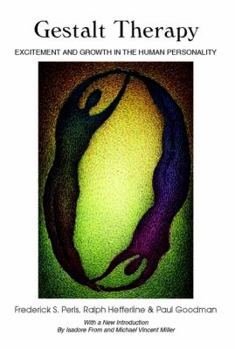Gestalt Therapy: Excitement and Growth in the Human Personality
Select Format
Select Condition 
Book Overview
The seminal text setting forth the theoretical foundations of Gestalt therapy. Originally published in 1951, The Gestalt Journal Press edition restores the work to its original editorial structure and... This description may be from another edition of this product.
Format:Paperback
Language:English
ISBN:0939266245
ISBN13:9780939266241
Release Date:January 1951
Publisher:Gestalt Journal Press
Length:512 Pages
Weight:1.85 lbs.
Dimensions:1.0" x 6.0" x 9.0"
Customer Reviews
3 ratings
The classic text
Published by Thriftbooks.com User , 18 years ago
Perhaps it is not a coincidence that there is so little writing about gestalt therapy, since the therapy emphasizes experience over explanation. In any case, the writing here is very important for those who wish to understand the intellectual basis of this approach. Gestalt therapy was written by three people. The significant part of the book, part II in the original published version, was written by Paul Goodman from the notes of Fritz Perls. Reputedly, Perls paid Goodman $500 for the job, but Goodman had trouble collecting. The publishers decided to make Hefferline's section Part I. This section contains a bunch of exercises that bear little relationship to what a Gestalt therapist would actual do with a patient. Isadore From, the famous Gestalt trainer, said that Part II was deliberately written so as not to be easily introjected (swallowed uncritically). The essence of Gestalt therapy is that change/learning takes place through experience, and that introjection, or simply swallowing what a therapist says to you is of no use. Thus, the text of Part II must be read line by line, as it was taught in year- long seminars by Isadore. When read this way, Perls, Hefferline and Goodman emerges as a rich source of insight and theoretical perspective about what was almost called "existential phenomenological therapy" by its creators.
a vital and pathbreaking work
Published by Thriftbooks.com User , 19 years ago
This initial formulation of Gestalt Therapy is the single most important development of the psychotherapeutic ideas of Freud and Reich. Personally, it has helped me begin to gain real insight into myself, my friends and family, and my society. Synthesizing psychoanalysis, western philosophy, and eastern meditation techniques, the book presents a new and vital perspective on mental health and illness, as well as a series of exercises and practices designed to bring us into closer contact with our daily experience and gain insight into the neurotic mechanisms by which we ward off excitement and growth. The book is divided into two parts (their intended order reversed by the publisher). In the second part, the foundational theory of Gestalt Therapy is layed out. The presentation is vague and unsystematic, but its insights and approaches are crucial. Breaking with Freud, and developing Wilhelm Reich's methods of Character Analysis, the authors shift the focus of therapy from our memories, dreams, and unconscious functions, onto our present, aware functions. Gestalt Therapy defines the self as our individual, historically, culturally, and biologically determined system of contacting our environment. Health, in GT terms, is the ability to recognize and act on elements in our environment to satisfy our impulses. The 'gestalt' comes from gestalt _psychology_, a non-therapeutic German experimental discipline which studied the way we discern 'figures' from the 'ground' of experience. (Think of the famous picture that looks like a candlestick or two silhouetted faces-- each of these images is a 'figure' or 'gestalt' formed from the 'ground' of light and dark on the page.) The crucial ability of the healthy individual, according to Gestalt _Therapy_ is the power to easily form 'gestalts' from the experiential 'ground' of daily life, recognizing opportunities for fulfillment in the environment and acting on them with vigor and grace. Unhealth, or neurosis, on the other hand, is conceived of in GT as 'interrupted excitement', a habitual breaking of contact with our environment and our impulses, an inability to form gestalts. Our neuroses work by avoiding novelty, tensing our muscles against impulses, and projecting our desires and resentments onto others. These neurotic strategies, Goodman and Perls observe, are pandemic in our culture, and manifest themselves in widespread anxiety, boredom, resentment, and violence. Part One contains a series of 18 exercises in awareness and contact through which we can begin to recognize our neurotic mechanisms and the impulses they ward off. They form the practical core of the Therapy, and deal variously with focusing attention on breathing, body sensations, emotional reactions, eating, and speech, etc. Some are more clearly conceived and presented than others. Ultimately, this great book is not a theoretical template to be applied. Rather, it provides an orientation, and an _invitation_ to assume the responsi
A book worth to read again from time to time.
Published by Thriftbooks.com User , 25 years ago
This book has meant much to me personally. I always suggest that people buy the book for themselves. I am so dissappointed because I did not get my book back from someone who borrowed it. However, for me it is worth it to buy another one.





